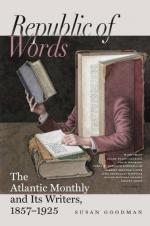were so long that one got lost in them, and had finally
to go back and clutch a nominative case and drag it
down the page with him; there were ambiguities and
obscurities in plenty: her thoughts were so bright
that they darkened her words; one must go through a
process of initiation,—but having mastered
the style, one knew the writer. It was well worth
while, this shrouding rhetoric, for beneath it were
no reserves; superficially no one ever kept more out
of sight, but the real reader could not fail to know
that here he had the freedom of the author’s
nature: and although she somewhere said that a
woman “thus intensely feminine, thus proud and
modest, betraying herself to the world in her writings,
is an exception, and one in the whole world the most
rare,” she knew not that she sketched herself
in that exception. But there are not elsewhere
to be found pages so drenched with beauty as hers;
and for all her vague abstractions of language, and
wide, suffused effects, she possessed yet the skill
to present a picture, keenly etched and vividly colored,
in the fewest words, when she chose. Not to mention
Rose and Bernard, who, oddly enough, are a series of
the most exquisite pictures in themselves, bathed
in changing and ever-living light, let us take, for
instance, Maria Cerinthia walking in the streets of
Paris, having worn out her mantilla, and with only
a wreath of ivy on her head,—or Clotilda
at her books, “looking very much like an old
picture of a young person sitting there,”—or
the charming one of Laura’s
pas, which
the little boy afterwards describes in saying, “She
quite swam, and turned her eyes upward,”—or,
better, yet, that portrait of a Romagnese woman:
“of the ancient Roman beauty, rare now, if still
remembered, with hair to her knees, wrapping her form
in a veil vivid as woven gold, with the emerald eyes
of Dante’s Beatrice, a skin of yellow whiteness,
and that mould of figure in which undulating softness
quenches majesty,—the mould of the mystical
Lucretia.” There are sea-sketches scattered
among these leaves which no painter’s brush will
ever equal, and morning and twilight gain new splendor
and tenderness beneath her touch.
But, after all, this was not her style’s chief
excellence; she cared little for such pictorial achievements,
and in presenting her fancies she often sacrificed
outline to melody; it is necessary for you to feel
rather than to see her meaning. What distinguished
her yet more was the ability by means of this style
to interpret music into words. Although this
may not be correct practice, there was never a musical
critic who did not now and then attempt it: musicians
themselves never do, because music is to them nothing
to see or to describe, but the air they breathe, and
in fact a state of being. Do you remember that
tone-wreath of heather and honeysuckle? “It
was a movement of such intense meaning that it was
but one sigh of unblended and unfaltering melody isolated
as the fragrance of a single flower, and only the




